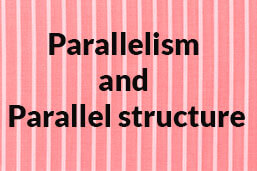
Parallelism, also known as parallel structure, includes essential grammatical and rhetorical language rules that involve using matching or similar grammatical structures in phrases, clauses, lists, or sentences. By ensuring each part of a sentence follows the same grammatical pattern, writers can create balance, clarity, and rhythm in their work. This method can also emphasize certain ideas or points. Whether in creative, professional, or academic writing, parallelism enhances readability and credibility.
Definition: Parallelism and parallel structure
Parallelism involves repeating a chosen grammatical form within a sentence. According to Cambridge English, it is an organizational pattern and a less obvious way to achieve connections within sentences and beyond.
Common types of parallelism used in academic writing include pairs or series, in addition to parallel outlines and headings.
Parallelism in a series
A series is three or more contiguous elements. We use commas to punctuate each component and – sometimes – before the coordinating conjunction. The last element connects to the previous ones with a coordinating conjunction: and, or, but (not) or (not) yet.
Nouns should go together in parallel and – similarly – adjectives appear alongside other adjectives. In contrast, a series where the components are in a different format may sound awkward and need clarification.
Parallel structure of words
Parallel words use the same patterns to show that two or more ideas are as important as each other. Let’s consider some examples.
Parallel structure of phrases
Like words, parallel phrases use the same grammatical structure. For instance, mixing verb phrases with noun phrases is considered a parallelism error. Likewise, when the series consists of several verb forms, we should not mingle the forms, i.e., gerunds (-ing form) with infinitives (starting with ‘to’).
Parallel structure of clauses
Similarly, clauses within sentences benefit from parallel structures. As an example, prepositional phrases ought to be uniform. Let’s consider some more examples.
Parallel structure after colons
After colons, keep all listed elements in the same form.
Parallelism in pairs
Pairs are connected ideas in a sentence. Next, we will consider how to use coordinating conjunctions – such as ‘for’, ‘and’, ‘or’, ‘but’, ‘so’, ‘nor’, and ‘yet‘ – to join parallel pairs.
Similarly, the next examples show how the correlative conjunctions – a type of connecting structure – also benefit from parallelism:
- Not only…but also.
- Either…or.
- Neither…nor.
Additionally, we can use parallel comparatives with ‘over’, ‘than’ and ‘as’.
Parallelism in outlines and headings
An outline should have a balanced structure that uses parallelism and coordination principles. Usually, nouns ought to be parallel with nouns, verb forms with verb forms, adjectives with adjectives and so on.
Another consideration in outlines is that items of equal significance should have similar numeral or letter designations, i.e., consistent value or weighting.
FAQs
Parallel structure is when two or more ideas use the same word patterns to show equal importance.
The structure connects ideas logically. Therefore, using parallelism in your writing will help clarify your self-expression and could increase readers’ delight.
Generally, yes. However, logical and clear writing takes priority in the few cases where flexibility with nouns and gerunds becomes necessary. Reasonableness is preferable to rigidity.
- ✓ 3D live preview of your individual configuration
- ✓ Free express delivery for every single purchase
- ✓ Top-notch bindings with customised embossing

